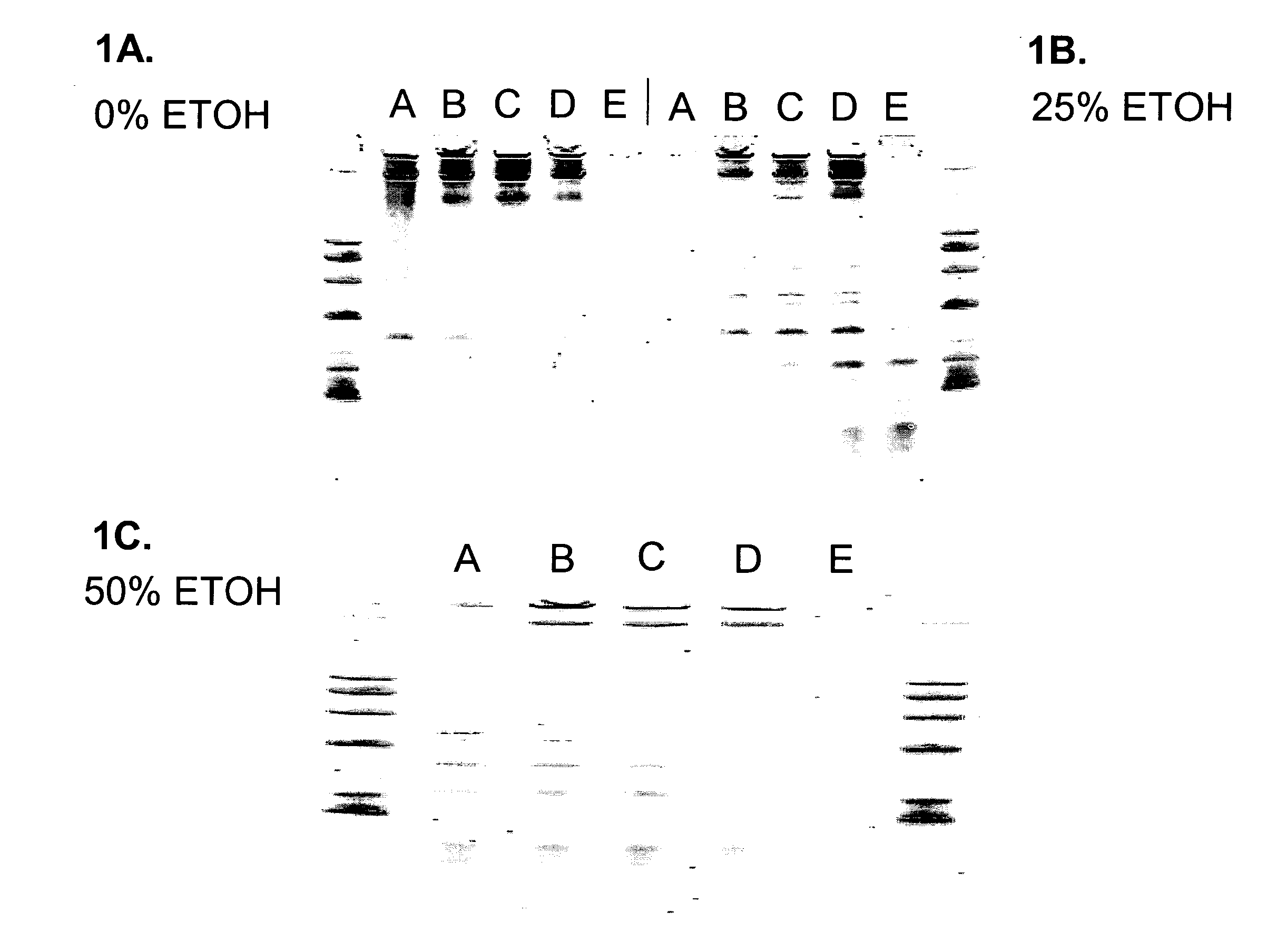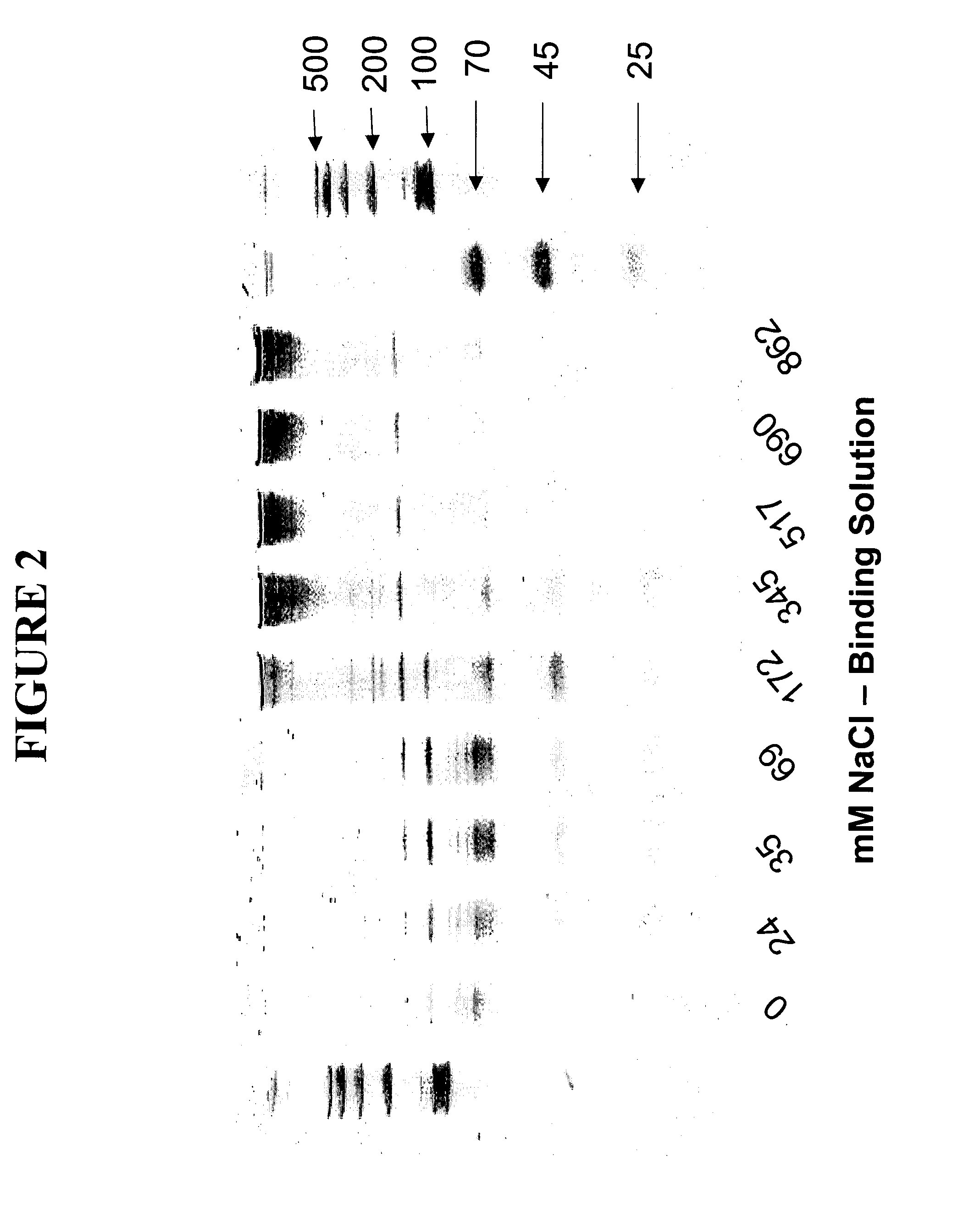Small RNA purification
a technology of rna and purification method, which is applied in the preparation of urea derivatives, organic chemistry, chemistry apparatus and processes, etc., can solve the problems of preventing quantitative recovery of small rna molecules and generally not considered useful, and achieve the effect of reducing the degradation of rna
- Summary
- Abstract
- Description
- Claims
- Application Information
AI Technical Summary
Benefits of technology
Problems solved by technology
Method used
Image
Examples
example 1
RNA Purification with a Compaction Agent and Different Ratios of GITC and Urea
[0087] This example describes the purification of RNA from a cell lysate using a compaction agent and different ratios of GITC and urea without using a separate lysate purification step. Five tubes, each containing 1×106 cultured 293T human cells were centrifuged at 8,000×g and rinsed twice with 500μl 1×PBS (phosphate buffered saline) pH 6.8 to remove cell culture media. PBS supernatant was removed after centrifugation of cells. To each of five tubes (tubes A-E) containing washed cells 4 M GITC (guanidine thiocyanate), 10 mM TRIS (tris(hydroxymethyl)aminomethane hydrochloride) pH 7.5 and / or 8 M Urea, 20 mM TRIS pH 7.5 was added in the following ratios: Tube A 175 μl GITC+0 μl Urea, Tube B. 130 μl GITC+45 μl Urea, Tube C. 85 μl GITC+90 μl Urea, Tube D. 45 μl GITC+130 μl Urea, Tube E. 0 μl GITC+175 μl Urea. Tubes were vortexed to resuspend cells. To each tube was added: (1) 2.5 μl 5 M NaCl in water and (2) ...
example 2
Single Membrane Small RNA Purification with Various Concentrations of NaCl
[0091] This example describes the small RNA purification from a cell lysate using urea, a compaction agent, and various concentrations of NaCl. The purifications were accomplished using just a single binding column membrane without using a separate lysate purification step. Nine tubes, each containing 1×106 cultured 293T human cells were centrifuged at 8,000×g and rinsed twice with 500 μl 1×PBS pH 6.8 to remove cell culture media. PBS supernatant was removed after each centrifugation of cells. To each tube was added: (1) 360 μl 8 M Urea, 20 mM TRIS pH 7.5, and (2) 60 μl 250 mM Hexamminecobalt(III)chloride (Sigma #H-7891) in 1×TE pH8.0. 5 M NaCl and 20 mM TRIS pH 7.5 was added to tube 0-8 in variable amounts as follows: Tube 0: 0 μl NaCl+125 μl, Tube 1: 3.5 μl NaCl+121.5 μl TRIS, Tube 2: 5 μl NaCl+120 μl, Tube 3: 10 μl NaCl+115 μl TRIS, Tube 4: 25 μl NaCl+100 μl TRIS, Tube 5: 50 μl NaCl+75 μl TRIS, Tube 6: 75 ...
example 3
Single Membrane Small RNA Purification with Various Concentrations of Hexamminecobalt(III)chloride
[0095] This example describes the small RNA purification from a cell lysate using urea and various concentrations of compaction agent Hexamminecobalt(III)chloride. The purifications were accomplished using just a single binding column membrane without using a separate lysate purification step. Nine tubes, each containing 1×106 cultured 293T human cells were rinsed twice with 500 μl 1×PBS pH 6.8 to remove cell culture media. PBS supernatant was removed after centrifugation of cells. To each tube was added: (1) 175 μl 8 M Urea, 20 mM TRIS pH 7.5 and (2) 5 μl 5 M NaCl, 300 mM Hexamminecobalt(III)chloride (HACC) (in 1×TE pH 8.0) and 20 mM TRIS pH 7.5 was added in variable amounts to tube 0-8 as follows: Tube 0: 0 μl HACC+95 μl TRIS, Tube 1: 2.5 μl HACC+93.5 μl TRIS, Tube 2: 5 μl HACC+90 μl TRIS, Tube 3: 7.5 μl HACC+87.5 μl TRIS, Tube 4: 10 μl HACC+85 μl TRIS, Tube 5: 12.5 μl HACC+82.5 μl T...
PUM
| Property | Measurement | Unit |
|---|---|---|
| concentration | aaaaa | aaaaa |
| pH | aaaaa | aaaaa |
| pH | aaaaa | aaaaa |
Abstract
Description
Claims
Application Information
 Login to View More
Login to View More - R&D
- Intellectual Property
- Life Sciences
- Materials
- Tech Scout
- Unparalleled Data Quality
- Higher Quality Content
- 60% Fewer Hallucinations
Browse by: Latest US Patents, China's latest patents, Technical Efficacy Thesaurus, Application Domain, Technology Topic, Popular Technical Reports.
© 2025 PatSnap. All rights reserved.Legal|Privacy policy|Modern Slavery Act Transparency Statement|Sitemap|About US| Contact US: help@patsnap.com



